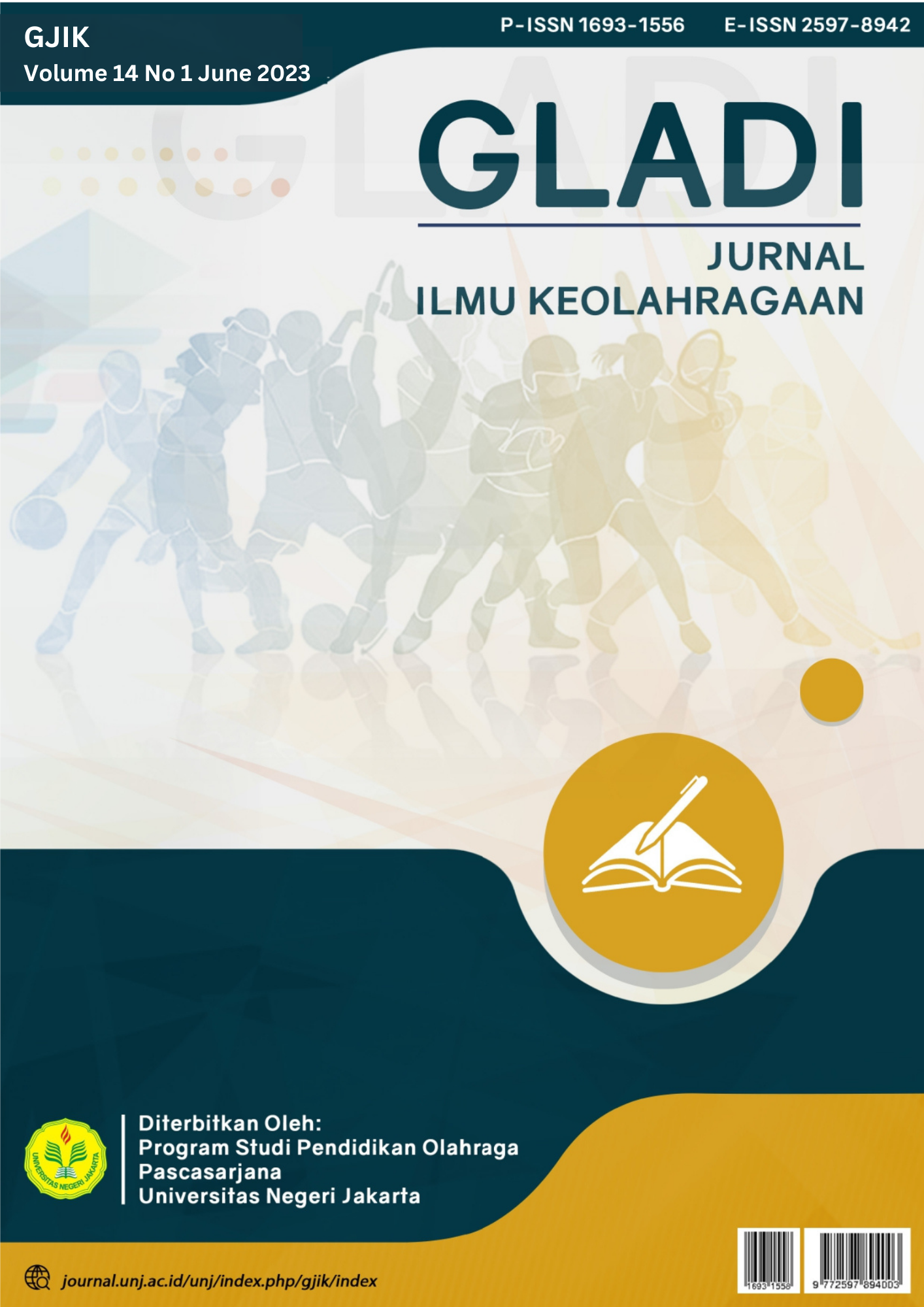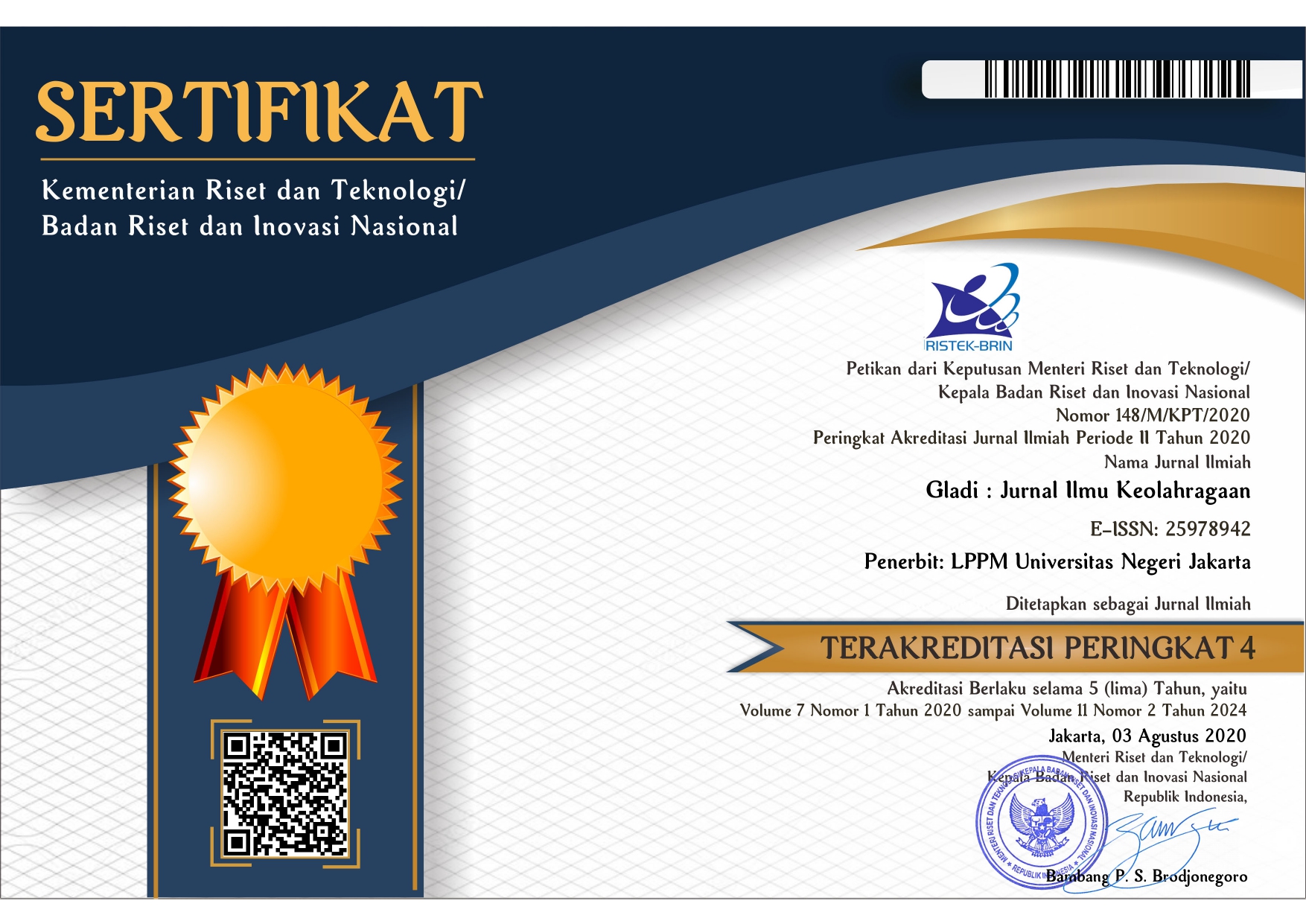Freestyle Soccer Training Model Based on Game For Elementary Children Aged 10-12 Years
DOI:
https://doi.org/10.21009/GJIK.142.02Keywords:
Exercise Model, Freestylesoccer, gameAbstract
The purpose of this study was to develop a game-based freestyle soccer training model for elementary school children aged 10-12 years and to find out the increase in students' interest in the game-based freestyle soccer training model for elementary school children aged 10-12 years. The method used is Research & Development with data analysis techniques used are qualitative descriptive analysis techniques and quantitative analysis techniques. This is intended to be able to reach or process all data or information so that a comprehensive explanation will be obtained. The number of samples is 20 respondents for the small test and 40 respondents for the large test. The steps taken in the research include: (1) Product design in the form of the results of a series of initial studies (2) Design validation by experts (3) Design improvement from validation results by experts (4) Limited product trials (6) Product revision (7) carry out the pre-test (8) re-test of use (9) Revise the product again (10) Implement the product after it has been repaired and is declared effective so that later the product can be applied (11) carry out the post-test. This study concludes that the game-based freestyle soccer exercise model can be applied effectively and there is an increase in student interest in the game-based freestyle soccer exercise model.
Downloads
References
Astri, L. A., Winarni, S., & Dharmawan, Y. (2016). Pengaruh Pemberian Pendidikan Kesehatan Reproduksi Terhadap Tingkat Pengetahuan Remaja Awal Sekolah Dasar Di Daerah Wisata Bandungan, Kabupaten Semarang Tahun 2016. Jurnal Kesehatan Masyarakat (e-Journal), 4(4), 213–219.
Beltasar, T. (2001). Pendekatan Keterampilan Taktis dalam Pembelajaran Sepakbola. Jakarta: Depdiknas.
D’Arcy, S. (2008). Freestyle Soccer Tricks: Tricks, Flick-ups, Catches. Richmond Hill, Ont. : Firefly Books. diakses: https://archive.org/details/freestylesoccert0000darc/mode/2up
Danny, M. (2007). Dasar-dasar Sepak Bola. Bandung: Pakar Raya.
Djaali, D. (2007). Psikologi pendidikan. Jakarta: Bumi Aksara.
Hasan, Z. (2014). Hubungan Koordinasi Mata-Kaki Dan Kecepatan Reaksi Dengan Keterampilan Juggling Freestyle Soccer (Studi Deskriptif Pada Komunitas Freestyle Soccer Bandung) [Skripsi. Universitas Pendidikan Indonesia]. diakses: http://repository.upi.edu/15736/.
Koger, R. (2007). Latihan Dasar Andal Sepakbola Remaja. Klaten: Saka Mitra Kompetensi.
Ma’Mun, A., & Subroto, T. (2001). Pendekatan Keterampilan Taktis dalam Permainan Bola Voli. Jakarta: Dirjen Olahraga.
Marbun, Y. F. (2014). Hubungan Kinestethic Perception dengan Keterampilan Juggling Freestyle Soccer. Skripsi. Universitas Pendidikan Indonesia.
Nor, A. W. (2017). Pengembangan Kombinasi Latihan Novice dan Advance dalam Permainan Sepakbola Gaya Bebas (Freestyle Football) pada Komunitas 360 Degree Freestyle Soccer Medan-Indonesia [Skripsi. Universitas Negeri Medan]. diakses: http://digilib.unimed.ac.id/22994/.
Pintrich, P., & Schunk, D. (1996). The role of Expectancy and Self-Efficacy Beliefs Motivation in Education: Theory, Research & Applications. Bergen County, NJ: Englewood Cliffs.
Sahlan, B. (2014). Kontribusi Daya Tahan Otot Tungkai Dan Daya Tahan Cardiovascular Terhadap Keterampilan Juggling Freestyle [Skripsi. Universitas Pendidikan Indonesia]. diakses: http://repository.upi.edu/7263/.
Sholehudin, I. (2014). Pengaruh Latihan Plyometrics Side Hop Terhadap Peningkatan Power Tungkai dan Terhadap Keterampilan Juggling Freestyle Soccer [Skripsi. Universitas Pendidikan Indonesia]. diakses: http://repository.upi.edu/7194/.
Siregar, N. M., Budiningsih, M., & Novitasari, E. F. (2018). Model Latihan Kelentukan Berbasis Permainan untuk Anak Usia 6 Sampai 12 Tahun. Prosiding Seminar Dan Lokakarya Fakultas Ilmu Keolahragaan Universitas Negeri Jakarta, 3(01), 75–87.
Susanto, A. (2016). Teori belajar dan Pembelajaran di Sekolah Dasar. Jakarta: Kencana.







